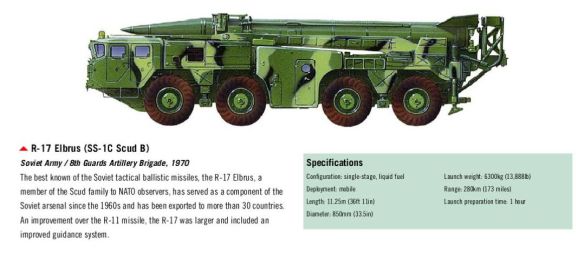Like those of the USA, the Soviet Union’s first post-war missile was a development of the German A-4; this led to the SS-1A (NATO = ‘Scunner’) with a range of 300 km and a 750 kg high-explosive warhead. The first nuclear battlefield missile to enter service (in 1957) was the Scud-A, which was mounted on a converted JS-3 heavy-tank chassis and carried a 50 kT warhead over a range of some 150 km. This was later supplemented by the Scud-B system, which carried a 70 kT warhead over a range of 300 km. Although Scuds were supplied to many other countries, nuclear warheads were only ever issued to the Soviet army and the system served throughout the Cold War, as plans to replace it with the SS-23 were cancelled as part of the INF Treaty.
The SS-12 (‘Scaleboard’) was a road-mobile, solid-fuelled ballistic missile, which was first fielded in 1962, followed by a modified version, the SS-12B (initially designated SS-22), in 1979. The missile had a maximum range of 900 km and a CEP of 30 m, carrying either a high-explosive or a 500 kT nuclear warhead, and system reaction time was estimated at sixty minutes. The SS-12B was withdrawn under the terms of the INF Treaty, and all missiles were destroyed.
One of the significant features of both the SS-1 and the SS-12 was that later versions were transported by 8 × 8-wheel TELs. These were highly mobile for off-road driving, were air-conditioned, accommodated the full crew and all necessary equipment, and even had an automatic tyre-pressure-regulation system. All these features enabled the missile detachment to move into a new location, set up the missile quickly, launch, and then move to a resupply point – the so-called ‘shoot-and-scoot’ tactic.
All Warsaw Pact exercises made use of battlefield nuclear weapons in support of attacks. A typical scenario, used some 233 weapons in the first strike, followed by 294 in the second strike. As used in these exercises, the intended purpose was to eliminate NATO forward troops – Area B, for example, coincided with the North German Plain. Following such a strike, the Warsaw Pact tank and motor-rifle units would have been able to advance rapidly into NATO rear areas.
The Soviet equivalent of the Honest John was known to NATO as the FROG (for Free Rocket Over Ground). The last model, the FROG-7, had HE, chemical, and nuclear warheads and a range of 42 miles. The SS-1C, known to NATO as the SCUD-B, was a guided missile with a range of 180 miles. During the Persian Gulf War, Iraqi-made crude versions of the SCUD proved widely inaccurate but were a tremendous nuisance to the Coalition, especially when Iraq fired them at Israel in a failed attempt to broaden the conflict. The Soviet SS-21 guided missile was a divisional-level system with a range of only 60 miles.
The SS-23 was an army-level system with a range of 300 miles. The SS-12 was a theater-level system with a range of 540 miles. All these Soviet systems carried nuclear warheads. Under the provisions of the Intermediate-Range Nuclear Forces (INF) Treaty, the United States agreed to eliminate the Pershing and the Soviets agreed to eliminate the SS-12 and SS-23.
Summit meeting between U. S. President Ronald Reagan and Soviet leader Mikhail Gorbachev held in Moscow during 29 May–2 June 1988. It was the fourth such meeting between Reagan and Gorbachev since 1985. For Reagan, the conference coincided with congressional hearings on the Iran-Contra Affair. Because of this, some critics speculated that the president was trying to divert attention from the scandal by creating a newsworthy achievement at the meeting. The major accomplishment of the summit was the signing of the already-ratified 1987 Intermediate-Range Nuclear Forces (INF) Treaty on 1 June 1988. It did not represent a breakthrough in arms control.
From the Soviet perspective, the 1988 summit greatly enhanced Gorbachev’s domestic and international prestige. This was because of the obvious close relationship between the two leaders and Reagan’s international reputation as an anticommunist hard-liner. Gorbachev’s heightened prestige gave him important political capital, which was needed as he continued to move forward with his perestroika and glasnost reforms.
The meeting was carefully crafted to focus on the INF Treaty. The treaty had been forged at the December 1987 Washington summit meeting between the two leaders and was approved by North Atlantic Treaty Organization (NATO) leaders in March 1988 and by the U. S. Senate on 29 May 1988. The treaty called for the destruction of 2,611 intermediate-range ballistic missiles (IRBMs) with flight ranges of 300–3,400 miles. Included in the treaty were U. S. Pershing II missiles and ground-launched cruise missiles as well as Soviet SS-4, SS-12, SS-20, and SS-23 missiles. It also specified very detailed on-site inspection and verification procedures. In accordance with the treaty, by 1991 both countries would have eliminated all intermediate- range nuclear missiles.
